The Criteria Cognitive Aptitude Test (CCAT) measures your critical thinking, problem-solving skills, and the ability to learn and apply new information to given situations. The test is an accurate predictor of overall job performance. With a set of 50 questions and a 15-minute time limit, you will be evaluated on logic, math, and verbal and spatial reasoning. The cognitive assessment provided by the CCAT Test is proven to be accurate and scientifically valid.
Did you know?
The CCAT Test has three different sections: (1) verbal reasoning, (2) logic & math, and (3) spatial reasoning. While different companies require different scores, the passing score for most jobs is 28. Test takers who succeed are generally strong critical thinkers who can move quickly through the questions on the test.
The test is taken online, and it reports your performance with respect to other candidates who took this test. The CCAT Test delivers insightful reports to employers, enabling them to make the best possible decisions. The scores achieved on this test consist of raw scores, percentile ranking, and sub-scores – all of which determine the test taker’s individual as well as relative cognitive abilities.
CCAT Question Types Explained
The Criteria Cognitive Aptitude Test assesses three aspects of your cognitive functions:
- Verbal reasoning – This is not an assessment of your reading and writing proficiency but a test of your vocabulary level, which reflects your general scholastic level and of your ability to find your way with words.
- Math and logic – This is not an assessment of your basic math skills but a test of your ability to quickly work with numerical and logical information presented to you in order to find a solution for a problem. However, the test does rely on your good command of basic math and pre-algebra.
- Spatial reasoning – These questions assess your ability to reason using fluid information (abstract shapes and figures) and arrive at conclusions based on just a few examples (inductive reasoning). You will need to assess the shape and structure of the figures, perhaps perform a mental rotation of shapes, and find the missing element based on your appraisal.
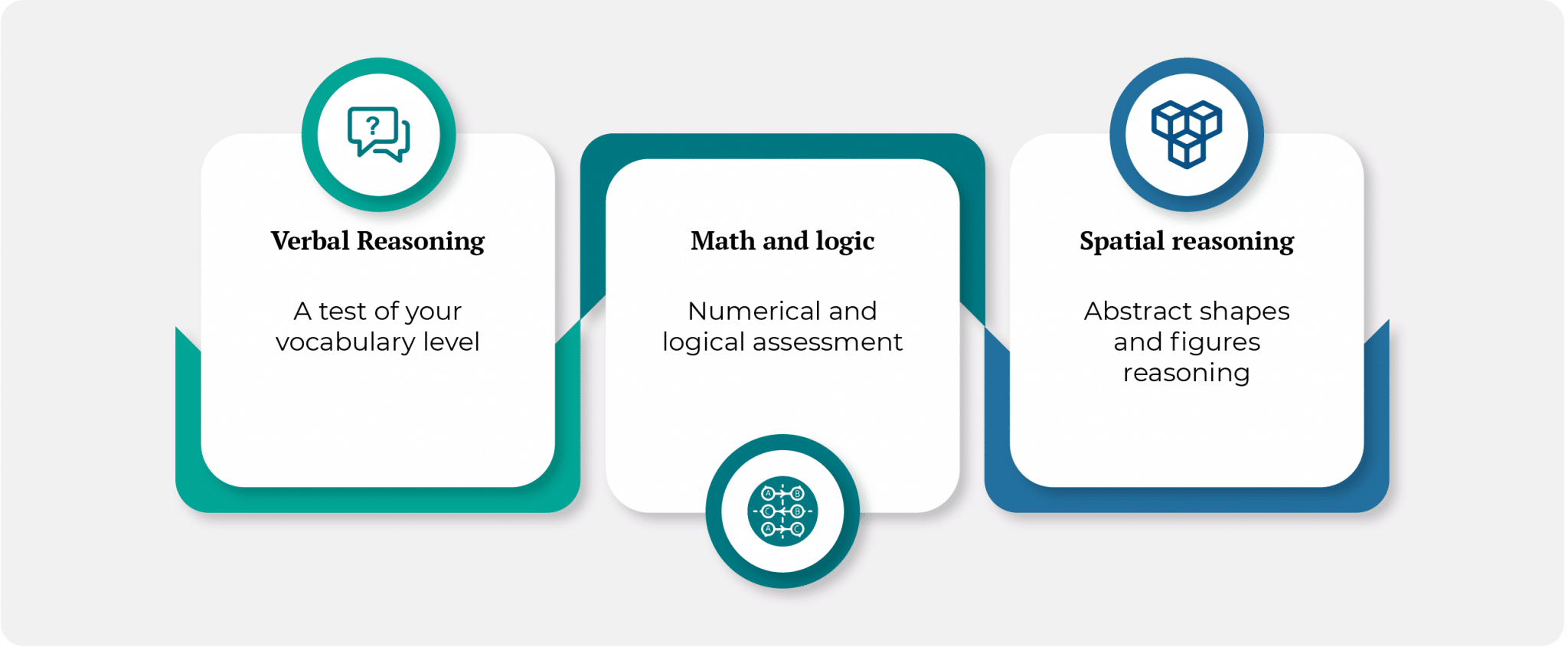
1. Verbal Reasoning
The following sections introduce the format of the various verbal CCAT questions, along with free sample questions and solving tips for each type of question.
Word Analogy
In these questions, you are presented with a pair of words (WORD A : WORD B). Your goal is to establish a specific relationship between the words and then, looking at your answer options, find the pair that contains the same relationship as the original pair.
Winning Tip for Word Analogy Questions
While solving analogies, the most important feature is to maintain the order of the analogy. If the analogy between word A and word B is “A works at B,” then an answer that presents a perfect analogy but in the reverse order (“B works at A”) will not be the correct answer.
Try a Word Analogy Sample Question
YACHT is to VEHICLE as…
- BOAT is to AUTOMOBILE
- BUS is to WATERCRAFT
- WHALE is to MAMMAL
- OCTOPUS is to ELEPHANT
- SAIL is to TRANSPORT
The correct answer is WHALE is to MAMMAL.
Explanation: The analogy underlying this question is A is a type of B. Specifically, in both the example and the correct answer, A is a maritime type of B.
The example – Yacht is a vehicle. Although “vehicle” may colloquially refer to land motor vehicles, the term also encompasses watercraft and aircraft.
The correct option – Whales belong to the family of mammals. Most mammals are capable of living on land, but there are some marine mammals who spend all of their lives at sea—the most familiar ones being whales and dolphins.
Sentence Completion
This is the most common form of verbal questions. You are presented with a sentence that includes one or two missing words. Your goal is to complete the sentence with the correct word/s. These questions usually assess your vocabulary level and your ability to create meaningful sentences and are less focused on grammar and syntax skills.
Winning Tip for Sentence Completion Questions
One of the best ways to complete a sentence is to use the simplest word you can think of and then look for a synonym or a different word that conveys the same meaning.
Try a Sentence Completion Sample Question
Choose the word or the words that, when inserted in the sentence to replace the blank or the blanks, best fits the meaning of the sentence.
___________ the team leader had been told by the HR manager that continuing to overload his team with tasks would be ___________ to his employees, he insisted on tightening the schedules.
- Because, disadvantageous
- Despite that, instrumental
- Although, detrimental
- Even though, unassailable
- Since, incremental
The correct answer is although, detrimental.
Explanation:
The sentence can be completed with pairs of words with either of these meanings (the phrasing is a reduction of the sentence):
- Even though he knew it was bad, he insisted… OR
- Because he knew I was good, he insisted…
The first option makes more sense and indeed the option “although, detrimental” presents a pair of words that fit it.
The meaning of the rest of the words and their essence in brackets:
- because, disadvantageous (bad) – creates an illogical connection
- despite that (although), instrumental (assisting, good) – creates an illogical connection
- even though, unassailable (certain, neutral) – the pair does not create a coherent sentence
- since, incremental (accumulative) – the pair does not create a coherent sentence
Antonyms
In these questions, look for the word that is most nearly the opposite of a given word.
Winning Tip for Antonym Questions
You should always have in mind that some words are homophones, which are words that are pronounced the same but have different meanings. The answers often rely on that and offer you words that are the opposite of a word that sounds the same to trick you. Take 2-3 seconds and make sure that the given word is spelled as you expect it to be spelled.
Try an Antonym Sample Question
Choose the word that is most nearly OPPOSITE to the word in capital letters
AUSPICIOUS
- mute
- undoubting
- cramped
- favorable
- unfortunate
The correct answer is unfortunate.
Explanation:
AUSPICIOUS means conducive to success; favorable. Unfortunate has exactly the opposite meaning – indicating a poor chance of success. Unfortunate has additional meanings, but these shouldn’t stop you from choosing it as the correct answer.
- Mute means something that is characterized by an absence of sound.
- Undoubting is the opposite of suspicious, a word that sounds and is written in a somewhat similar manner to auspicious.
- Cramped means uncomfortably small or restricted, an antonym of spacious – a word that sounds somewhat similar to auspicious.
- Favorable is, as written above, the direct meaning of auspicious, not its opposite.
Tips for a quick solution:
Tests makers often use words that have more than one meaning. The correct answer, which best represents the opposite of the given word, does not necessarily refer to the most common meaning of the word. Moreover, some distractors will be used only because they remind us of the other irrelevant meanings of the given word.
So how can you deal with it? Always ask yourself upon reading the word if it has multiple meanings. Once you have several possible meanings in mind, it will be easier to discern the option that is truly an antonym rather than just related.
Attention to Detail
In these questions, you are presented with several pairs of names, addresses, companies, etc. Your goal is to count how many pairs are identical and how many are different.
Winning Tip for Attention to Detail Questions
Make sure to have a pen or pencil and scratch paper before beginning the test. For each identical pair, draw a line. It is much easier to count lines than to keep the number in your head.
Try an Attention to Detail Sample Question
How many of the five items in the left-hand column are exactly the same as the corresponding entry in the right-hand column?
| 8017 Old Pierce St. | 8077 Old Pierce St. |
| 986 Jade Dr. | 986 Jade Dr. |
| 408 Bay View St. | 408 Bay View Dr. |
| 51 Greenrose Ave. | 51 Greenrose Ave. |
| 9326 Berry Ave. | 9326 Berry Ave. |
- 1
- 2
- 3
- 4
- 5
The correct answer is 3.
Explanation:
| 8017 Old Pierce St. | 8077 Old Pierce St. |
| 986 Jade Dr. | 986 Jade Dr. |
| 408 Bay View St. | 408 Bay View Dr. |
| 51 Greenrose Ave. | 51 Greenrose Ave. |
| 9326 Berry Ave. | 9326 Berry Ave. |
Tips for a quick solution:
Mistakes happen when you lose your concentration. Follow these two principles and you will probably answer these questions correctly:
- Don’t answer the questions too fast. Take your time! And yet, by “take your time,” we mean 2-2.5 seconds per item.
- Approach the questions one by one, top to bottom. Rapid shifting between items causes careless mistakes
2. Math & Logic
The following sections introduce the format of the various numerical CCAT questions, along with free sample questions and solving tips for each type of question.
Direct Calculations
These are straightforward basic math questions. You may be required to perform percent-based calculations, to find the arithmetic mean (the average) of a group of numbers, or to decide which value of a series of values is the highest/lowest value.
Winning Tip for Direct Calculations Questions
Working with percentages may be confusing for anyone who does not use them on a day-to-day basis. If you are not 100% sure about your percent-based calculation skills, open any of the many math sites available online, and refresh your skills. When you delve into iPrep’s practice tests, you will get many mental math tips to help you execute these problems quickly
Try a Direct Calculations Sample Question
8.5 is 50% of what number?
- 17
- 4.25
- 25.5
- 16
- 58.5
The correct answer is 17.
Explanation: This is a classic “reverse percentage” type of question, as an equation it is written:
8.5 = 50% * X
In this case, 50% is in fact half (1/2). Using this conversion, you can simply solve:
| 8.5 = 50% * X | Convert to fractions |
| 8.5 = 1/2 * X | Multiply by 2 (the inverse of 1/2) |
| 2*8.5 = 2*1/2 * X | Simplify |
| 17 = X |
Tips for a quick solution:
Watch out for misleading distractors. For example, answer choice B (4.25) is in fact 50% of 8.5, while you are requested to find 8.5 is 50% of what number.
Math Word Problems
This is the most prevalent type of question on the CCAT. These math questions involve different types of math calculations, anywhere from basic operations to statistics and probability. Your task is to read the question, translate it into a mathematical problem, and solve the problem. Like all the rest of the questions, you only have about 20 seconds to solve these, which creates rigorous time pressure, especially for math word problems.
Winning Tip for Math Word Problems Questions
In most cases, the best course of action is not to complete the calculations but to systematically eliminate answers until you are left with a single answer. Since there must be a correct answer, you can mark it and move onwards. The detailed solutions of iPrep include many elimination techniques.
Try a Math Word Problem Sample Question
Two thousand movie tickets were sold for the new movie during the first week of its release. How many tickets were sold during the second week if ticket sales dropped 55% in comparison to the first week?
- 900
- 950
- 1000
- 1050
- 1100
The correct answer is 900 tickets.
Explanation: This question essentially requires you to know how to perform direct percentage calculations. We’ll present three different methods to solve this problem. We advise you to read them all in order to strengthen your command of the different possible ways to approach questions like these.
Solution A – the common way to work percentages:
In percentage problems, the whole is always 100% and the increment/deduction is calculated with respect to the whole. You can always use this formula in order to understand what the increment/deduction’s value is:
(Whole/100) X value of increment/deduction. In our case, the whole is 2,000 tickets. The required deduction is 55%; therefore, the calculation is:
2000/100 X 55 = 20 X 55 = 1100.
Tickets sold the second week = whole – 55% = 2000 – 1100 = 900.
Solution B – breaking the whole into pieces
It is always easier to work with wholes because they make solving the problem simpler. In this case, you might notice that the whole is 1000X2. 1000 makes a more convenient whole than 200, as every increment/deduction can be immediately calculated in relation to it.
A 55% decrease from 1000 ticket sales is 550 sales, therefore:
1000 sales –> 550 fewer sales
2000 sales –> 2 X 1000 sales –> 2 X 550 fewer sales –> 1100 fewer sales
Solution C – breaking the increment/deduction into pieces
It is also easier to work with “simple” percentages. For example, without using a calculator, it might be easier to calculate a 21% increase, by summing 10% + 10% + 1%.
In this case, you need to calculate a reduction of 55%. This means that you can find what 50% + 5% reductions are separately and then add them to the overall increase.
50% of 2000 is simply half of the number
100% = 2000 –> 50% = 2000/2 = 1000
5% are 1-tenth of 50% –> 5% = 50%/10 = 1000/10 = 100
Overall ticket-sales reduction = 55% = 50% + 5% = 1000 + 100 = 1100.
Tip for a quick solution: Always use elimination even if you are uncertain of the final answer. If 2000 tickets were sold in the first week and the ticket-sales drop was over 50%, this means that the correct answer must be less than half or below 1000. Even if you are not sure how to get to the correct answer, choose either option A or B to increase your chances of getting the right answer.
Table/Chart Problems
In these questions, you need to examine information in the form of a table or a chart (e.g. columns chart, pie chart) and solve a mathematical problem. You are usually not required to do complex calculations or advanced reasoning but to use the relevant information.
Winning Tip for Table/Chart Problems Questions
Do not spend time understanding the chart first. Read the question and only then look for the specific detail you need.
Try a Chart Sample Question
The local community center hosts Yoga classes every evening. The number of participants each evening is presented in the chart below. What is the ratio of male to female participants in evenings in which there are more women participants than men?
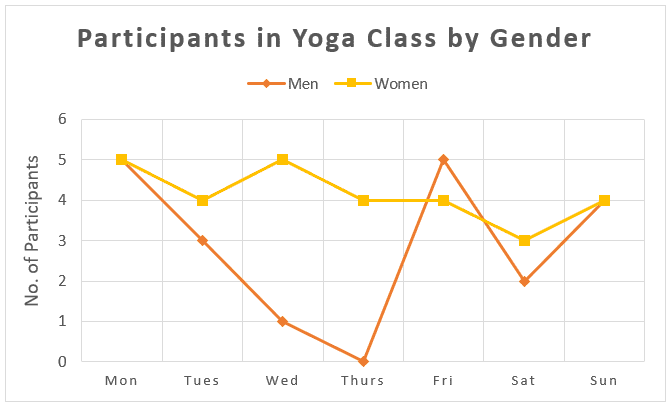
The correct answer is 3:8.
Explanation: According to the chart, on Tuesdays, Wednesdays, Thursdays, and Saturdays more women participate in the Yoga class than men.
The number of female participants (women) on these days is 4+5+4+3 = 16.
The number of male participants (men) on these days is 3+1+0+2 = 6.
Therefore, the ratio of men to women is 6:16 and reduced by 2 –> 3:8
How to approach questions that include chart interpretation:
- A significant portion of the information presented in tables and graphs questions is usually irrelevant to solving the question. The reason is that in addition to your math skills, your table/graph information extraction and analysis are also assessed. Your first goal in these questions is not to fully understand the information presented to you, but to understand what information you should look for. Therefore, reading the question must always precede examining the chart.
- Notwithstanding, if a title for the chart exists, it is important to read it before reading the question, as it usually provides the essence of the information presented within it and can often help to better understand the question.
- Therefore, the best order to approach a chart question is to: A.) read the title of the chart; B.) read the question and understand it; C.) examine the chart and seek the relevant information for solving the question; and D. answer the question.
Number/Letter Series
In these questions, you are presented with a sequence of numbers or a sequence of batches of letters. Your goal is to determine which of the options is the next number/letter/batch of letters in the series.
Winning Tip for Number/Letter Series Questions
Letter series relies on the Latin alphabet. The differences between the letters are usually based on constant differences between the letters (e.g. a…d…g…j… are three letters away from one another in the sequence.) Therefore, you must know the alphabet by heart.
Try a Number Series Sample Question
What is the next number in the following series of numbers?
7 10 15 22 31
- 39
- 41
- 42
- 40
The correct answer is 42.
Explanation:
Look at the differences between the numbers: and the difference between the differences:
7 10 15 22 31
+3 +5 +7 +9
+2 +2 +2
The difference between each term is greater by two in every step. Therefore, the difference between the last displayed number of the series and the next number should be 9 + 2 = 11
Therefore, the next number of the series is 31 + 11 = 42
For learning purposes, calculate the values of the differences of the series if you had continued the series:
+3 +5 +7 +9 +11 +13 +15
Therefore, the next numbers of the series would be:
42 + 13 = 55
55 + 15 = 70
Critical Thinking
These questions assess your ability to critically assess syllogisms and decide whether they are true, false, or if their validity cannot be determined. Usually, you will get two premises that you should consider as true.
Winning Tip for Critical Thinking Questions
If a conclusion is definitely not true, this doesn’t mean that it is definitely false. A conclusion must directly contradict the premises in order to be considered “false.” If it is definitely not true but it does not directly contradict the premises, the correct answer is “cannot be determined.”
Try a Critical Thinking Sample Question
Assume the first two statements are true. Is the final statement: 1) True, 2) False, or 3) Uncertain based on the information provided?
Elly is not friends with Sam’s friends
Jules, Jack, Sam, and Dylan are all friends
Sam might be Elly’s friend
- True
- False
- Uncertain
The correct answer is True.
Explanation:
This logic question can be classified as a “relationships” type. In these questions, you are asked to determine whether information about some individuals and their relationships with one another is sufficient to get to the proposed conclusion.
Statement A tells us that Elly is not friends with Sam’s friends. Notice that it does not tell us anything about the relationship between Elly and Sam themselves.
Statement B introduces four individuals – all of them are friends. Therefore, Jules, Jack, and Dylan are Sam’s friends, and we can deduce that they are not friends with Elly.
The proposed conclusion is that Sam might be Elly’s friend. Both statements neither prove nor contradict the possibility that Sam and Elly are friends. “Might” is a word that describes feasibility. Since Elly’s and Sam’s friendship was not excluded, it is still possible, and the conclusion is true.
3. Spatial Reasoning
The following sections introduce the format of the various abstract/figural CCAT questions, known as spatial reasoning. The introduction is accompanied by free sample questions and solving tips for each type of question.
Shape Sequence
In these questions, you are presented with a series of 3-5 elements, which represent a meaningful sequence. Your task is to identify the next element in the series.
Winning Tip for Shape Sequence Questions
If the element includes multiple shapes or features, start by focusing on just one of them. Check whether you find some underlying logic to its progression along the sequence. If you do, try locating that feature within the given answers. From here on, you can continue examining only the answers that include that feature in the correct position. You can eliminate the rest of the answers. Repeating this process 2-3 times is usually sufficient to eliminate all the answers but one, which must be the correct answer.
Try a Shape Sequence Sample Question
Which of the following boxes should replace the question mark (?) to complete the pattern?
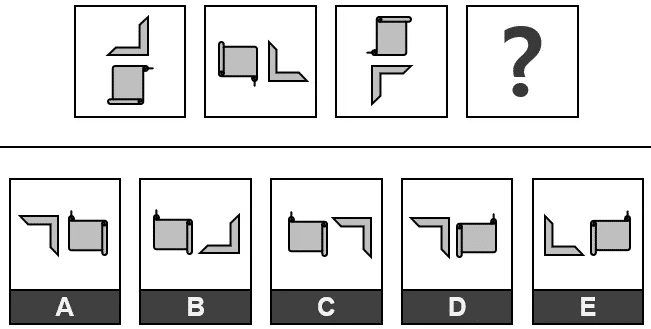
The correct answer is A.
Each element is comprised of two inner components. From left to right, on each step, the entire element rotates 90 degrees clockwise.
Notice that what makes answer D incorrect is that the scroll is flipped horizontally.
Finding the Odd One Out
You are presented with five elements; each element may either be a single shape or several shapes assembled together. Your goal is to identify the element that has one feature that can distinguish it from the rest of the elements and mark it.
Winning Tip for Odd One Out Questions
The features of the shapes are usually very obvious: type of shape, number of shapes, and shape orientation. Focus on one feature. If you see that it is uniform across some elements, mark it in your mind and check whether it is uniform in all the elements but one.
Try an Odd One Out Sample Question
Which of the following does not belong?

The correct answer is D.
All the elements but element D are comprised of two types of shapes.
Element D is comprised of three types of shapes.
Matrix Completion
You are presented with a 3-by-3 matrix of figural elements. One of the elements is missing and you need to find the missing element within the answers. In most cases, there is some underlying logic in the organization of the elements according to their position by row and by column.
Winning Tip for Matrix Completion Questions
Look at the matrix as three parallel figural sequences, either a horizontal sequence (by row) or a vertical sequence (by column). Two series will be complete and one will be missing one element. Choose one direction, either by row or by column, and try to recognize a similarity in the features of the two complete series. Once you identify it, project it to the third one and find the element among the answers that will complete the third series so it shares the similarity.
Try a Matrix Completion Sample Question
Which of the following boxes should replace the question mark (?) to complete the pattern?
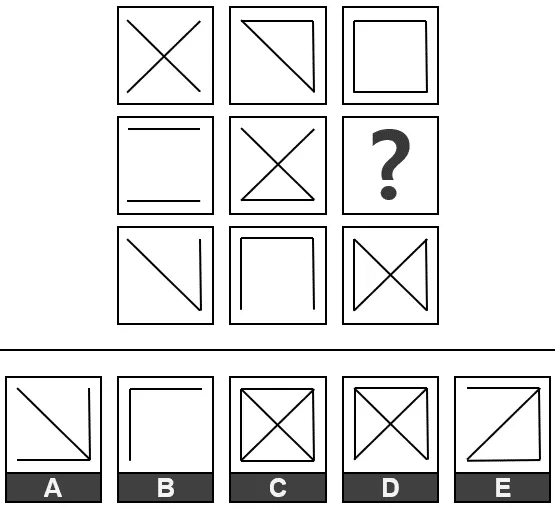
The correct answer is E.
The solution is based on the number of lines constructing each element. All the elements are based on the prototypical shape ![]() and are comprised of only some of the shape’s lines.
and are comprised of only some of the shape’s lines.
The elements in the left column are comprised of two lines.
The elements in the middle column are comprised of three lines.
The elements in the right column are comprised of four lines.
The missing element should be comprised of four lines. Only option E is comprised of four lines; therefore, it is the correct answer.
Tip: Consider the matrix as three short series, either horizontal (rows) or vertical (columns). Once you identify a process that happens in the two complete rows/columns, try to project it to the third one as well.
CCAT Test Preparation Strategies
1. Have one goal in mind while you are preparing – beat the clock
None of the CCAT questions is extremely difficult, but answering 50 questions in 15 minutes can be extremely difficult and stressful. Here are some tips:
- While practicing, you should re-examine the questions and ask yourself how you could answer the questions a little bit faster.
- You do not always have to complete the calculations in order to pick the correct answer; in most cases, you can eliminate all the answers but one faster than verifying that the remaining answer is correct.
- Pick up time-efficient solving tips that the explanations offer you, learn how to avoid time traps, and create your own personal time-saving methods.
2. Focus on your strengths and learn how to earn easy points
The average score for a CCAT test taker is 24 points. The pass mark for most companies and positions is 28 points. You need 32-35 points to be considered a top candidate for almost any position. And to a recruiter, a score of 38 points implies that you practically have superpowers. This should help you understand that getting a high score is more important than getting all the questions right. While practicing, you should pick up techniques that help you get more answers correctly even at the expense of forfeiting a few questions on the way. While answering questions on the actual test, you can focus on questions that you find easier to answer both quickly and correctly and let go of questions that require your greater and longer attention.
- Remember that there are three main categories of questions: verbal, math & logic, and spatial reasoning. You need basic skills in each of these. If you experience great difficulty with any of the categories, prepare in advance so you can boost your success rate in them. But if there is only one type of question within a category that is difficult for you, skip it and focus on your stronger areas.
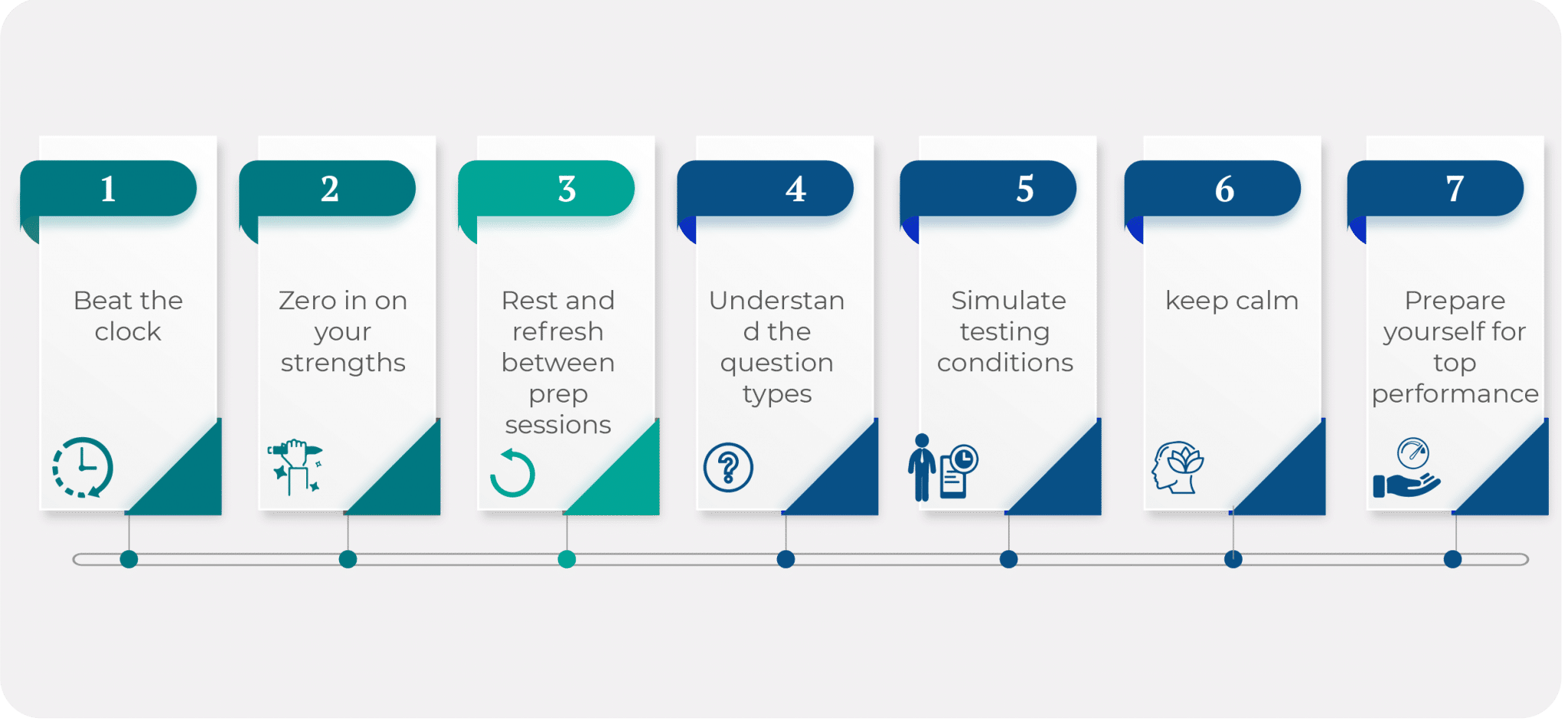
3. Try to find at least two preparation time slots, and take a break between them and before approaching your real test
Our brain has its ways of learning. During a preparation session, you can improve and improve but there comes a time when you reach your peak, and improving becomes much more difficult. Surprisingly, if you take a significant break between preparation sessions, in which you rest and refresh yourself, you can get back and continue to improve in the next preparation session. The same goes for the actual test. It is not recommended to complete a rigorous preparation session and then immediately take the real test. Take some time, let everything sink in, take a revitalizing break, and only then approach the test—most people will find it easier to implement all the helpful solving techniques they have attained during their preparation sessions with a break in which to process them.
- That being said, it is recommended to “start your (brain) engine” and answer a few questions before attempting the real test, which should increase your focus.
4. Learn exactly what is required of you in each type of question
The instructions you get in the CCAT may sometimes be a bit confusing or unclear. One of your key goals during preparation should be to understand exactly what is required of you in each type of question. This serves two purposes: first, less confusion and greater confidence, and second, less time spent on reading the instructions, which means more time to answer the questions.
5. Prepare in a way that incorporates the real test’s conditions
Practice full-length tests—50 questions in 15 minutes. Strictly maintain the time limit. Apply all the test limitations (not even a short break after the clock has started, no mobiles, no calculators, no skipping between questions, etc.) This will make many stress-inducing elements of the test much less intimidating.
6. Try to keep calm
You know yourself better than everybody else. Everyone has the optimal level of stress in which he or she performs best. It is usually somewhere between the area in which you are laid back and too complacent, and the area in which the stress is starting to impair your learning and performance. Take all the means to put yourself in that optimal stress area in both the practice sessions and while taking the actual test.
7. Prepare yourself for top performance conditions—eat well, sleep well, reduce disturbances
We mentioned solving tips and the importance of finding your stress comfort zone. Add to that nutritious meals and some good night’s sleep to promote concentration and focus. Also, make sure that you are learning and taking the test in surroundings that reduce disturbances. Take into account noise reduction or concentration-inducing sounds, like music, and appropriate lighting. If you are taking the test outside of your home, practice taking the test under similar conditions—bringing earplugs or a pillow for your back and a water bottle to stay hydrated while you test yourself under those conditions.
Test Features
The CCAT is a cognitive ability assessment test that measures your ability to think critically and solve problems. Successful test takers demonstrate their ability to digest and apply new information, as well as learn new skills.
The test is used to predict the performance of middle and upper-level positions, including management roles, sales executives, executive assistants, software developers, and analysts.
There are 3 categories of CCAT questions:
- Verbal Reasoning
- Logic & Math
- Spatial Reasoning
CCAT verbal reasoning questions test you on letter sequences, antonyms, and syllogisms. A syllogism is a question where the question makes two statements and asks the test taker if there are any conclusions they can make based on the given statements.
The CCAT logic and math questions challenge you with number sequences and word problems. These questions test your ability in fractions, decimals, basic algebra, multiplication, and division. Calculators are not allowed, but you can use a pencil and paper when working out the answers.
The CCAT spatial reasoning questions focus on your ability to recognize patterns. The questions challenge you to identify the odd-one-out, look at matrices, and inductive reasoning, with the goal of assessing your ability to solve problems using visual information.
CCAT scores are instantly tabulated, and you’ll receive a detailed report within moments of completing the test.
iPREP: Concise. Focused. What you need.
Sign up
Immediate access
Practice
Online self-paced
Pass
Ace that Test!
Technical Facts
- There are 50 multiple-choice questions. Test takers have 15 minutes to answer the questions. Only 1% of test-takers complete all 50 questions.
- The average CCAT test taker gets 24 answers correct.
- Question types: verbal, math and logic, and spatial reasoning.
- Calculators are not permitted during the test. However, our course provides you with the tips and tricks you’ll need to correctly answer math questions.
- Top employers from around the world administer the CCAT to potential employees. The test has been given over 500,000 times, as a method for screening workers before they are hired.
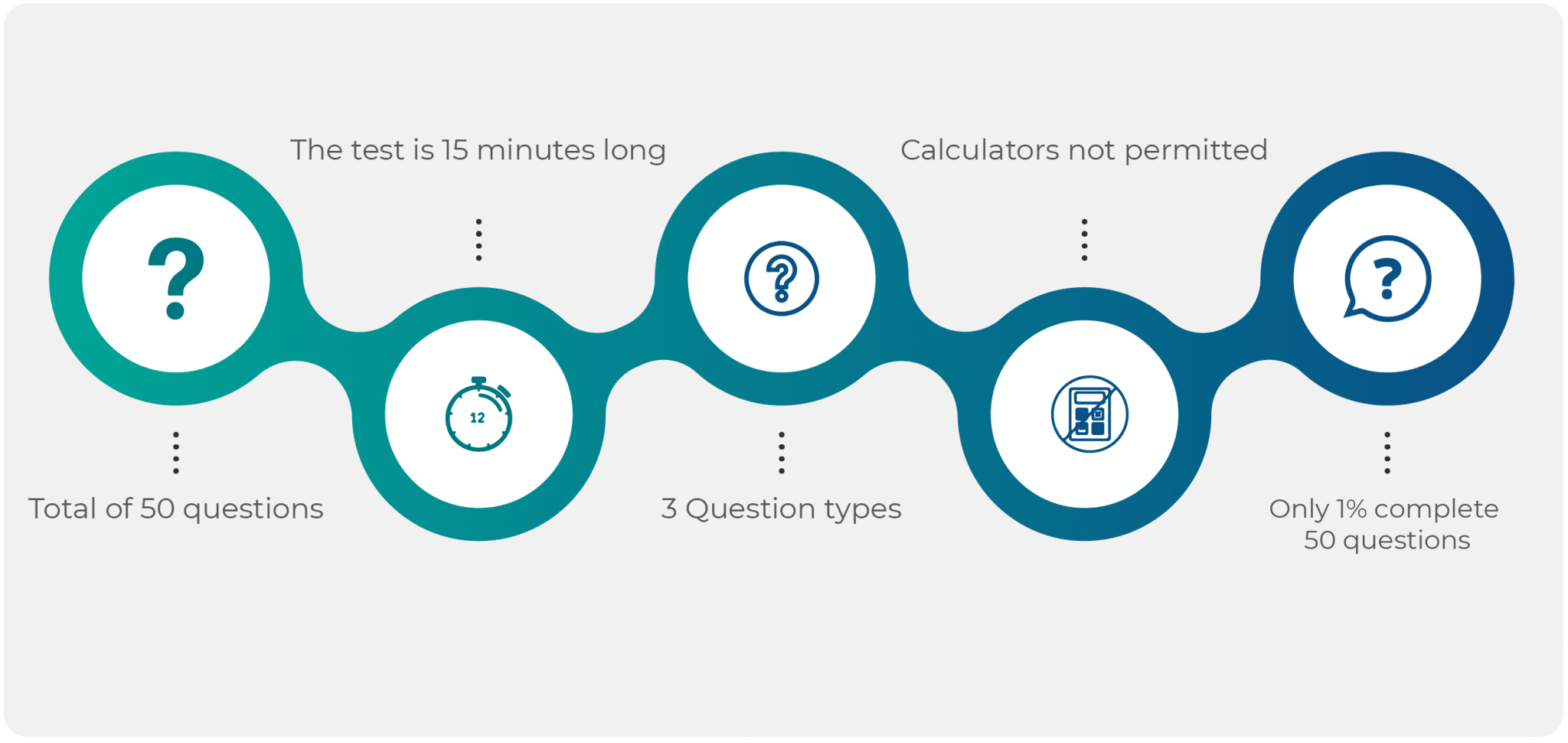
Companies Using CCAT
The CCAT is administered in all 50 states and in 18 countries internationally. It is used in over a dozen industries, including government positions, health care, financial services, and retail. The test is used to evaluate candidates at all levels of the organization, from entry-level roles to senior management positions, including individuals with advanced degrees such as attorneys, engineers, and programmers.
Two such companies that use CCAT are Vista Equity Partners and CrossOver.
Vista Equity Partners – CEO Robert Smith believes that testing helps his company find talented people who have been overlooked by other companies due to a weak resume. At Vista, the test is used to recruit talent as well as to help company employees rise to senior management employees in the company.
The company has a number of subsidiaries (including Tibco, Marketo, Solera, Infoblox, Cvent, Mindbody, and Apptio) and considers the test to be a crucial piece in the hiring process. Candidates who want to work for the company or one of their subsidiaries have the opportunity to display their potential through the tests, making it vitally important that one be prepared for the timed test before going in for an interview.
CrossOver – The company connects individuals from low-income companies with high-paying jobs in the United States. It requires its candidates to take the CCAT as part of their application process. Test takers need to be prepared, as they may only take the test once within a 6-month time period.
Also Used as Admissions Test
Contemporary continuous education constantly changes, and nowadays, it is possible to get hi-tech and technological education, and even professional certifications, via online platforms. Some of these institutes have adopted the Criteria Cognitive Aptitude Test as an integral part of their application process. For example, Lambda school, which remotely trains web developers and data scientists, screens applicants by administrating the CCAT twice.
Common and past names of the test
- Cognitive assessment test
- CCAT assessment test
- Cognitive ability test
- Cognitive test online
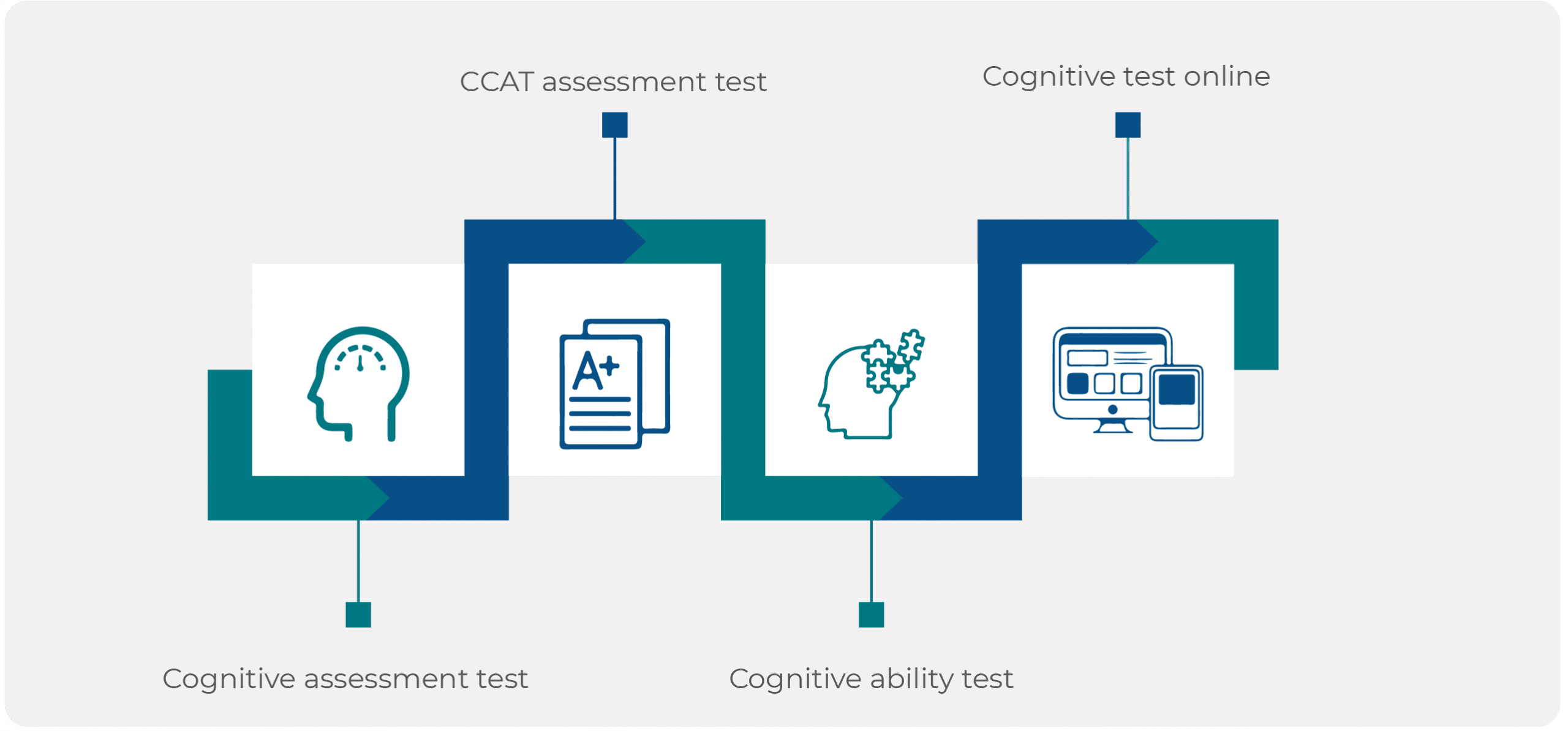
Results Scale and Interpretations
The results of the CCAT Practice Test are comprehensive and give powerful and detailed insight into your cognitive abilities in relation to a job’s specifications. You get your report immediately after you complete the test. The results and interpretations of the test can be explained using four categories:
1. Raw Score
Once you take the CCAT Test, you will be provided with a raw score. A raw score indicates the number of questions answered correctly. For instance, if your raw score is 30, it means that you have correctly answered 30 out of 50 questions.
The average raw score is 24.
2. Percentile Ranking
The raw score is converted into a relative performance metric called ‘percentile ranking.’ This indicates your score in comparison to others who have taken the test. For instance, if your percentile ranking is 44, it means that you scored better than 44% of test takers.
3. Sub-Scores
You also receive separate scores for each of the three sections: (1) logic and math, (2) verbal ability, and (3) spatial reasoning. The scores you receive in these categories are percentiles, meaning that if you scored a 25 in logic and math, 50 in verbal ability, and 75 in spatial reasoning:
- 25 = you scored better than 25% of other test takers in logic and math
- 50 = you scored better than 50% of other test takers in verbal ability
- 75 = you scored better than 75% of other test takers in spatial reasoning
4. Score Range
While every company has its own internal way of interpreting scores and assessing its candidates’ ability to perform in different roles, Criteria Corp. has suggested score ranges for positions, based on national norms that they have compiled.
For example, someone looking for an accounting/finance position should score between 24-39, while store managers should score between 20-37. Successful customer service representatives score between 18-32, while lawyers and company vice presidents score between 29-42.
5. Score Report
Your score report is two pages. As shown in the results summary figure, the first page shows your raw score and the percentile that you finished.
Your score will be further broken down by category, as shown in the Results Details section. This allows you to see what percentile you placed in for spatial reasoning, verbal ability, and math & logic.

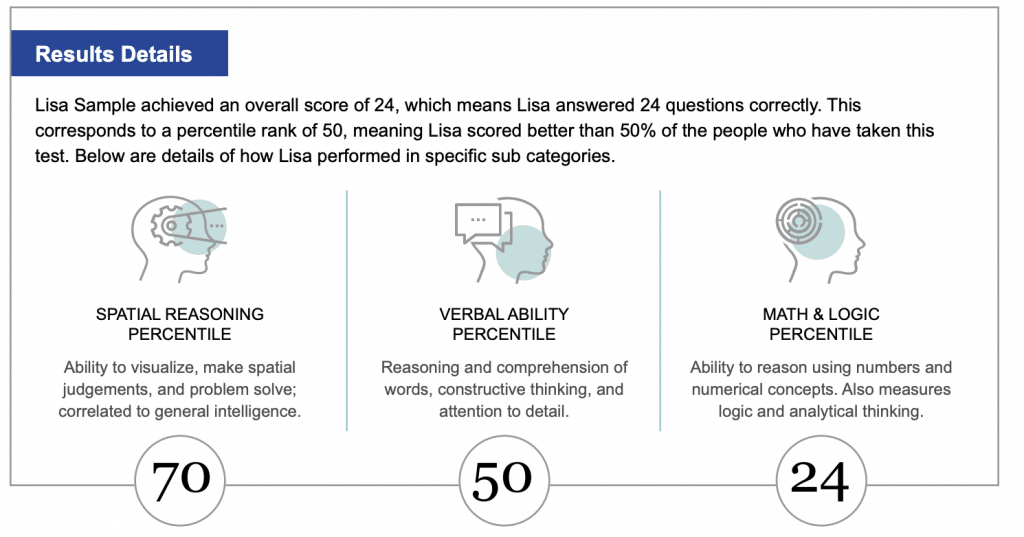
The final section on the first page shows your raw score, and how you rank compared to other people who have worked in a similar position.
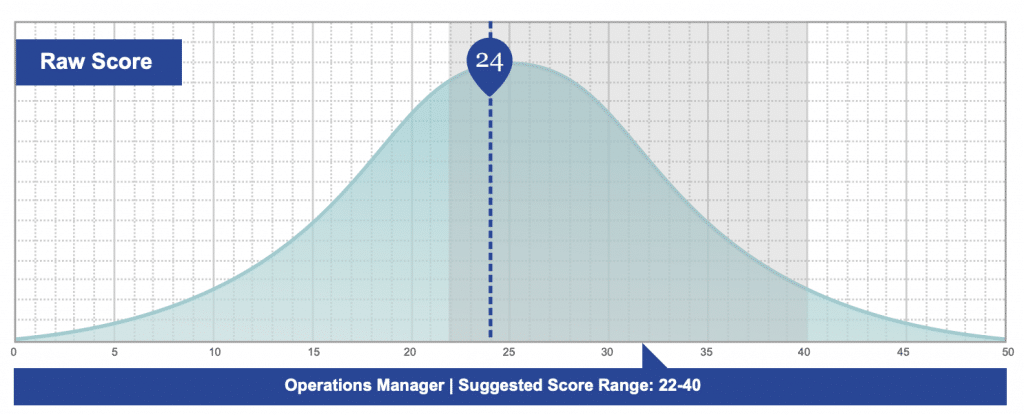
The second page lists different positions, and the recommended score you would need to achieve success in those jobs, as shown in the Suggested CCAT Score Ranges by Position figure.
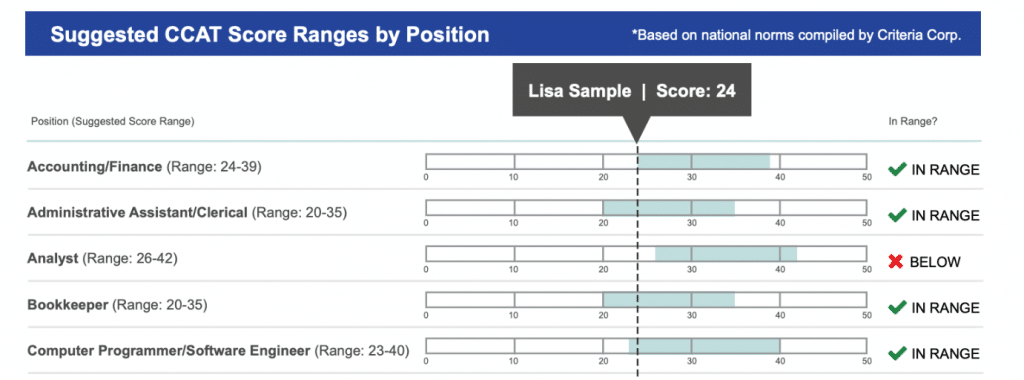
CCAT FAQs
The CCAT, which stands for Criteria Cognitive Aptitude Test, measures a potential employee’s verbal, math, and spatial skills. It is a pre-employment aptitude test that lets potential employers know how well you solve problems, learn new skills, and think critically.
The test has been administered over 500,000 times and is used by hundreds of companies around the world in their hiring process.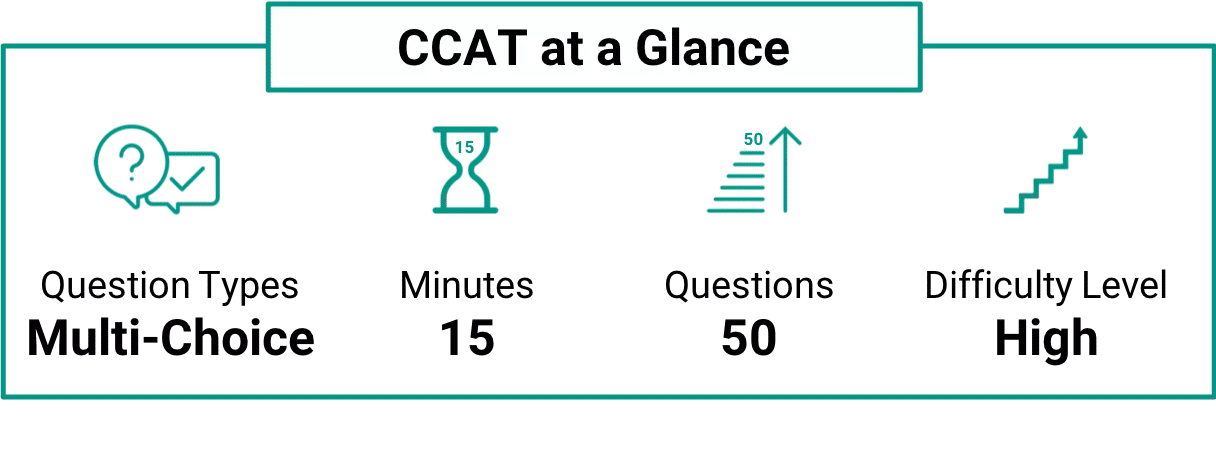
The Criteria Cognitive Aptitude Test is comprised of a total of 50 questions in three different sections:
1. Verbal
2. Math and logic
3. Spatial reasoning
You will be given only 15 minutes, which means that you have less than 20 seconds to answer each question – if you can get to them all.
Luckily, there is no need for you to answer all the questions, as less than 1% of the candidates do this in the given time. Instead, focus on answering as many questions correctly as you can.
Once the test is complete, Criteria will generate your raw score and percentile ranking. These indicate the number of correctly answered questions and your ranking versus those of the other test takers.
The CCAT is used to predict the performance of middle and upper-level positions, including management roles, sales executives, executive assistants, software developers, and analysts.
The required enhanced cognitive abilities of these types of roles are measured by the CCAT.
The test is very difficult, especially for a candidate who has never seen it. There are 50 questions covering three very different types of information, which need to be completed within 15 minutes. Less than 1% of all candidates answer all 50 questions during the test.
The difficulty does not stem from the difficulty level of each specific question but from other factors such as the severe time constraints (18 seconds per question), the exposure to unfamiliar question formats, and the need to continuously switch from solving one type of question to another.
However, candidates who take practice tests and understand the types of questions they will be working on have a significant advantage. Practices allow you to pace yourself, find your areas of strength, and perform well on the test.
Taking timed tests in a true test environment is the most effective way to practice for the CCAT. In addition, you’ll want to find a practice test provider that explains the reasoning behind correct and incorrect answers and offers techniques for moving through the test quickly.
Candidates can achieve significant test result improvements by investing a few hours a day for 2-3 days before the test.
Cognitive tests like the CCAT are a way for companies to assess candidates in a variety of skills during the hiring process.
The CCAT is not an IQ test. IQ tests measure intelligence, while the CCAT measures the skills that employees will need to perform on the job.
The CCAT is a cognitive ability assessment test that measures your ability to think critically and solve problems. Successful test takers demonstrate their ability to digest and apply new information, as well as learn new skills. These attributes all demonstrate your ability to succeed in a new job.
CCAT reports are highly accurate in predicting success on the job. According to Criteria, the tests developer, the test is twice as powerful a predictor of success as your interview, three times as powerful as your resume, and four times as powerful as your educational background.
The average CCAT score is 24, which would be in range for over 80% of the positions Criteria Corp. tracks.
Individuals who are looking for jobs like customer service representative, receptionist, or production manager can qualify for those positions with a score of 18, while attorneys and senior managers need to score 29 or higher to be considered viable candidates.
CCAT scores are instantly tabulated, and you’ll receive a detailed report within moments of completing the test.

CCAT Test Tips
1. Know the Instructions
During preparation, take the time and read the instructions carefully and then plan your test strategy to score high. In any event, you should avoid wasting time on instructions during the real test—that’s what practicing is for.
2. Manage Your Time
Don’t forget that time will be ticking down on your screen! You don’t have to answer all the questions to impress your future employer. Don’t spend more than 20-30 seconds on any one question. Also, while the CCAT does not allow you to go back to review questions, you also don’t lose points for incorrect answers. So if you are in doubt with a question, it’s better to make an educated guess and move to the next one.
3. Know Your Strengths
Through practice, you will be able to identify question types that you answer more intuitively and faster. Try to answer all of them. More importantly, you will probably identify question types that you find to be more difficult. Some of us are slow readers, some are confused by percentages, some have a weaker command of grammar. If you encounter a question for which you know you will need to more time, mark one of the answers and move forward. It is not worth it to lose 20 seconds on a question and only then to decide to move on.
4. Answer Enough Questions Correctly
“Enough” does not mean answering all the questions correctly. Only a small fraction of test-takers finish taking the test and even fewer people answer all the questions correctly. It is that difficult!
On average, people answer only 24 out of 50 test questions correctly. For the vast majority of the jobs, if you manage to get 28 correct answers out of 50, you will surely move on to the next step of the recruitment process. The requested score, however, changes according to the job level you apply for.
5. Plan your CCAT Strategy
– Your goal is to answer enough questions correctly not to answer all the questions of the test correctly.
– Take your best guess.
– Do not spend too much time on any one particular question.
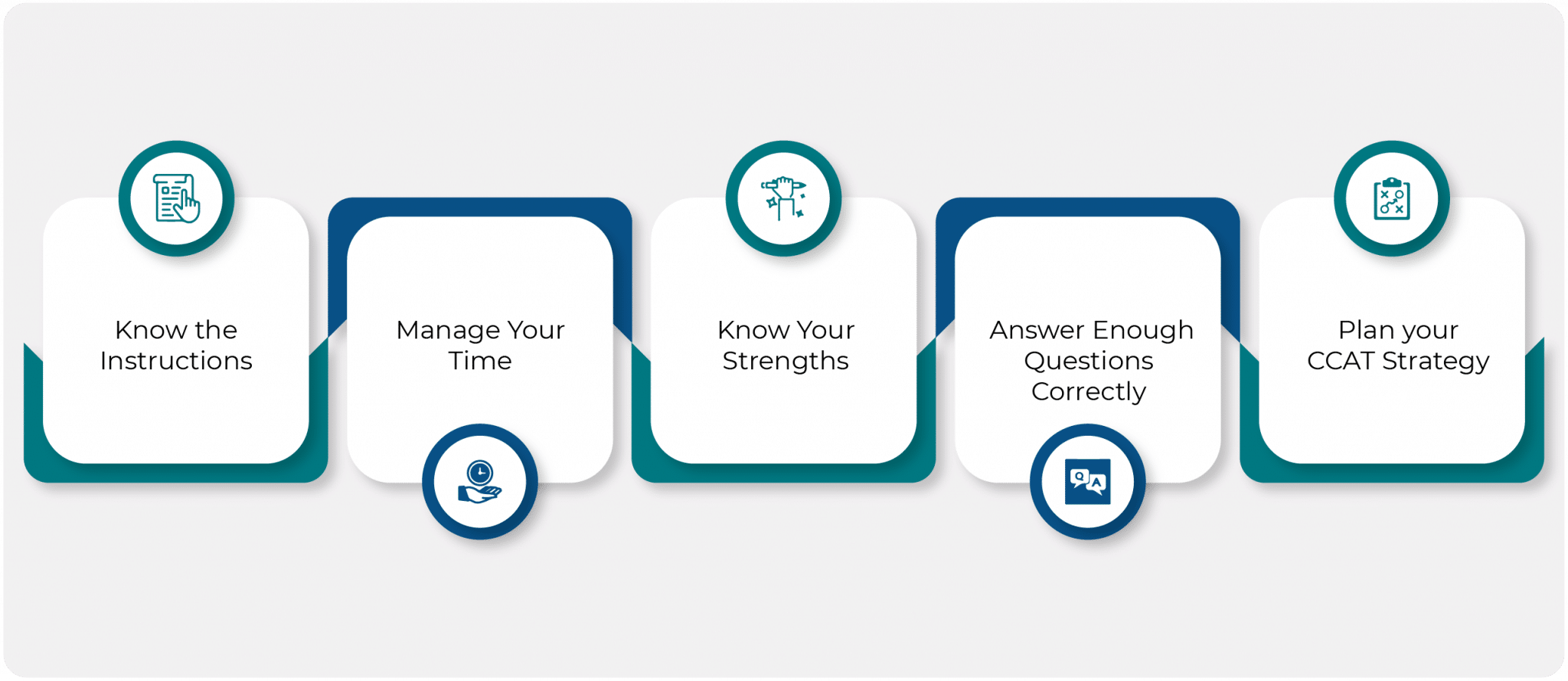
Administration
- Test Location: The first attempt is often non-proctored and taken online at home. Candidates who passed the CCAT test may be required to retake the test in a proctored environment by the hiring company, typically in their office.
- Test Schedule: The CCAT test generally takes place following at least an initial interview.
- Test Format: Multiple choice on computer.
- Test Materials: Test taken on a computer. Calculators are prohibited, but pen and paper are permitted.
- Cost: None.
- Retake Policy: Determined by each employer.
Test Provider
Established in 2006, Criteria Corp. provides a variety of online pre-employment assessment services helping organizations select the best candidates for various positions. The service is available in 18 countries around the globe. The Criteria Cognitive Aptitude Test (CCAT) is the aptitude assessment service of Criteria’s top product – HireSelect, software consisting of a number of assessment services, including personality and skill tests.
Information Sources
Disclaimer – All the information and prep materials on iPrep are genuine and were created for tutoring purposes. iPrep is not affiliated with Criteria Corp, which is the owner of the Criteria Cognitive Aptitude Test, or with any of the companies mentioned above.
Free CCAT practice test: Get to know what the Criteria Cognitive Aptitude Test (CCAT) will be like by practicing with these sample questions:
Question 1 of 15
Which of the following boxes should replace the question mark (?) to complete the pattern?
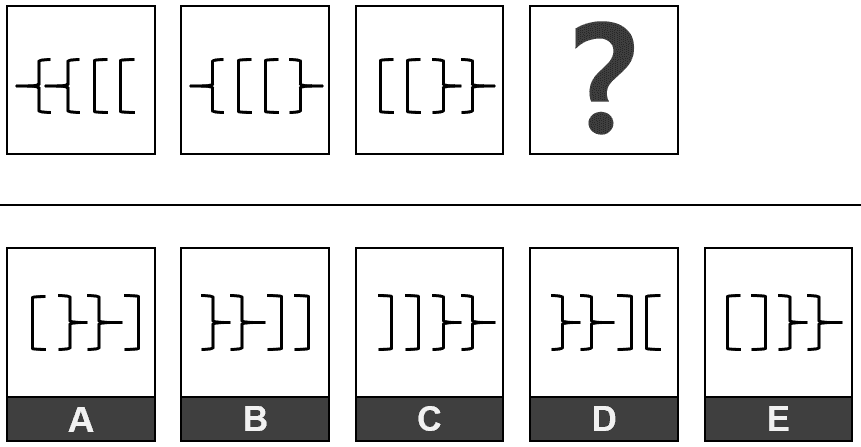
The correct answer is A.
Each element contains four brackets aligned horizontally. From left to right, the leftmost bracket of an element becomes the rightmost bracket of the next element. In its new location, the bracket rotates 180 degrees.
Question 2 of 15
Which of the following boxes should replace the question mark (?) to complete the pattern?

The correct answer is A.
Each element is comprised of two inner components. From left to right, on each step, the entire element rotates 90 degrees clockwise.
Notice that what makes answer D incorrect is that the scroll is flipped horizontally.
Question 3 of 15
Which of the following boxes should replace the question mark (?) to complete the pattern?

The correct answer is E.
The solution is based on the number of lines constructing each element. All the elements are based on the prototypical shape ![]() and are comprised of only some of the shape’s lines.
and are comprised of only some of the shape’s lines.
The elements in the left column are comprised of two lines.
The elements in the middle column are comprised of three lines.
The elements in the right column are comprised of four lines.
The missing element should be comprised of four lines. Only option E is comprised of four lines; therefore, it is the correct answer.
Tip: Consider the matrix as three short series, either horizontal (rows) or vertical (columns). Once you identify a process that happens in the two complete rows/columns, try to project it to the third one as well.
Question 4 of 15
Which of the following does not belong?

The correct answer is D.
Each element contains four straight lines. In all elements but D, one of the lines intersects with an additional one or two lines. Since there are no intersections in element D, it is the odd one out.
Question 5 of 15
Which of the following does not belong?

The correct answer is D.
All the elements but element D are comprised of two types of shapes.
Element D is comprised of three types of shapes.
Question 6 of 15
Choose the word that is most nearly the opposite of “COMMEND”:
- comply
- certify
- criticize
- prevail
- dissuade
The correct answer is criticize.
“Commend” means to praise formally or officially. “Criticize” is exactly the opposite – it means to indicate the faults of someone or something in a disapproving way.
Question 7 of 15
Choose the word that, when inserted in the sentence to replace the blank, best fits the meaning of the sentence:
The union delegates claimed they acknowledge that what they did was unfair and wrong and want to _________ it by repealing the notorious tax regulations.
- compensate
- condone
- eradicate
- rectify
- revamp
The correct answer is rectify.
The correct answer is “rectify,” which means to put something right; or correct. The sentence presents an improper situation and the sense is that the delegates want to correct it. “Rectify” is the most appropriate word for it.
Question 8 of 15
BIRD is to EGG as…
- HUMAN is to WOMB
- BUTTERFLY is to CATERPILLAR
- SPAWN is to FISH
- CONTEMPORARY is to ARCHAIC
- GUITAR is to MUSIC
The correct answer is HUMAN is to WOMB.
The analogy: the first word is the offspring that develops in the second word.
Question 9 of 15
Choose the word that is most nearly OPPOSITE to the word in capital letters
SANCTION
- Award
- Stiffen
- Alleviate
- Soothe
- Calm
The correct answer is Award.
Sanction is a word with two different meanings:
- A threatened penalty for disobeying a law or rule.
- Official permission or approval for an action.
Because the meanings are almost contradictory, people may get confused and think that sanction may also mean to ban something, which it does not.
Award is the opposite of a penalty; therefore, it is the correct answer.
The answers are in fact synonymous with the different meanings of sanction. Ratification is the action of signing or giving formal consent to something, which is also a synonym. It may be confused with gratification, which may be considered nearly the opposite of sanction.
Solving Tip:
Test makers often use words that have more than one meaning. The correct answer, which best represents the opposite of the given word, does not necessarily refer to the most common meaning of the word. Moreover, some distractors will be used only because they remind us of the other irrelevant meanings of the given word.
Question 10 of 15
Steven bought five similar soda cans for $3.20. How much does a single can of soda cost?
- 58 cents
- 62 cents
- 56 cents
- 64 cents
- 60 cents
The correct answer is 64.
One dollar is worth 100 cents. $3.20 equals 320 cents.
320 cents / 5 soda cans = 64 cents per soda can.
Question 11 of 15
Which of the following has the lowest value?
- 2/3
- 5/9
- 7/13
- 4/7
- 3/5
The correct answer is 7/13.
Explanation:
Notice that the denominators of all five values are odd numbers and that all the numerators are the lowest natural number, respectively, that is higher than half of the denominator, (i.e. if you subtract 1 from the numerator, its value will be lower than the denominator). In every fraction, the higher the denominator is, each equal part of the fraction contributes a lower value to the overall value of the fraction. Therefore, 1/3, which is the one part above the half in 7/13, contributes the lowest value across all options.
Question 12 of 15
What is the next number in the following series of numbers?
7 10 15 22 31
- 39
- 41
- 42
- 40
The correct answer is 42.
Explanation:
Look at the differences between the numbers:
7 10 15 22 31
+3 +5 +7 +9
+2 +2 +2
The difference between each term is greater by two in every step. Therefore, the difference between the last displayed number of the series and the next number should be 9 + 2 = 11
Therefore, the next number of the series is 31 + 11 = 42
Question 13 of 15

As of 2008, what is most nearly the percentage of US Black Protestants of all US Protestants?
- 8%
- 9.5%
- 12.5%
- 14%
- 16.5%
The correct answer is 12.5.
Black Protestants = 7%
All Protestants = Evangelical + Mainline + Black = 29 + 20 + 7 = 56%
Black Protestants as part of all Protestants =
7/56 = [reduce fraction by 7]
1/8 = [recall basic conversions from fraction to percentage]
12.5%
Solving Tips:
- Attention to detail – chart questions are not always difficult. Your main challenge is to extract accurate information. If one misses the notion that Black Protestants are part of the entire group of Protestants, he or she will get a faulty answer.
- Focus – even if the statistical information is relevant for you, remember NOT to spend any time examining and appreciating the information provided. It doesn’t matter whether it is accurate or not. Focus solely on the data as time is precious in this test.
Question 14 of 15
Assume the first two statements are true. Is the final statement: 1) True, 2) False, or 3) Uncertain based on the information provided?
Benevolent people donate money to charity and have pets.
Thomas donates money to charity and has no pets.
Thomas is not a benevolent person.
- True
- False
- Uncertain
The correct answer is True.
Statement A provides a rule: Benevolent people → donate money to charity AND have pets. This rule states that being benevolent entails two different properties that have to go together.
Statement B provides information: Thomas + does donate money + without pets.
Conclusion – Thomas is not a benevolent person. Thomas has only one of the necessary properties for being benevolent. Therefore, according to the first two statements, the conclusion is true.
Remember that previous knowledge or common sense are irrelevant for solving these types of questions.
Question 15 of 15
How many of the five items in the left-hand column are exactly the same as the corresponding entry in the right-hand column?
| 8017 Old Pierce St. | 8077 Old Pierce St. |
| 986 Jade Dr. | 986 Jade Dr. |
| 408 Bay View St. | 408 Bay View Dr. |
| 51 Greenrose Ave. | 51 Greenrose Ave. |
| 9326 Berry Ave. | 9326 Berry Ave. |
- 1
- 2
- 3
- 4
- 5
The correct answer is 3.
| 8017 Old Pierce St. | 8077 Old Pierce St. |
| 986 Jade Dr. | 986 Jade Dr. |
| 408 Bay View St. | 408 Bay View Dr. |
| 51 Greenrose Ave. | 51 Greenrose Ave. |
| 9326 Berry Ave. | 9326 Berry Ave. |
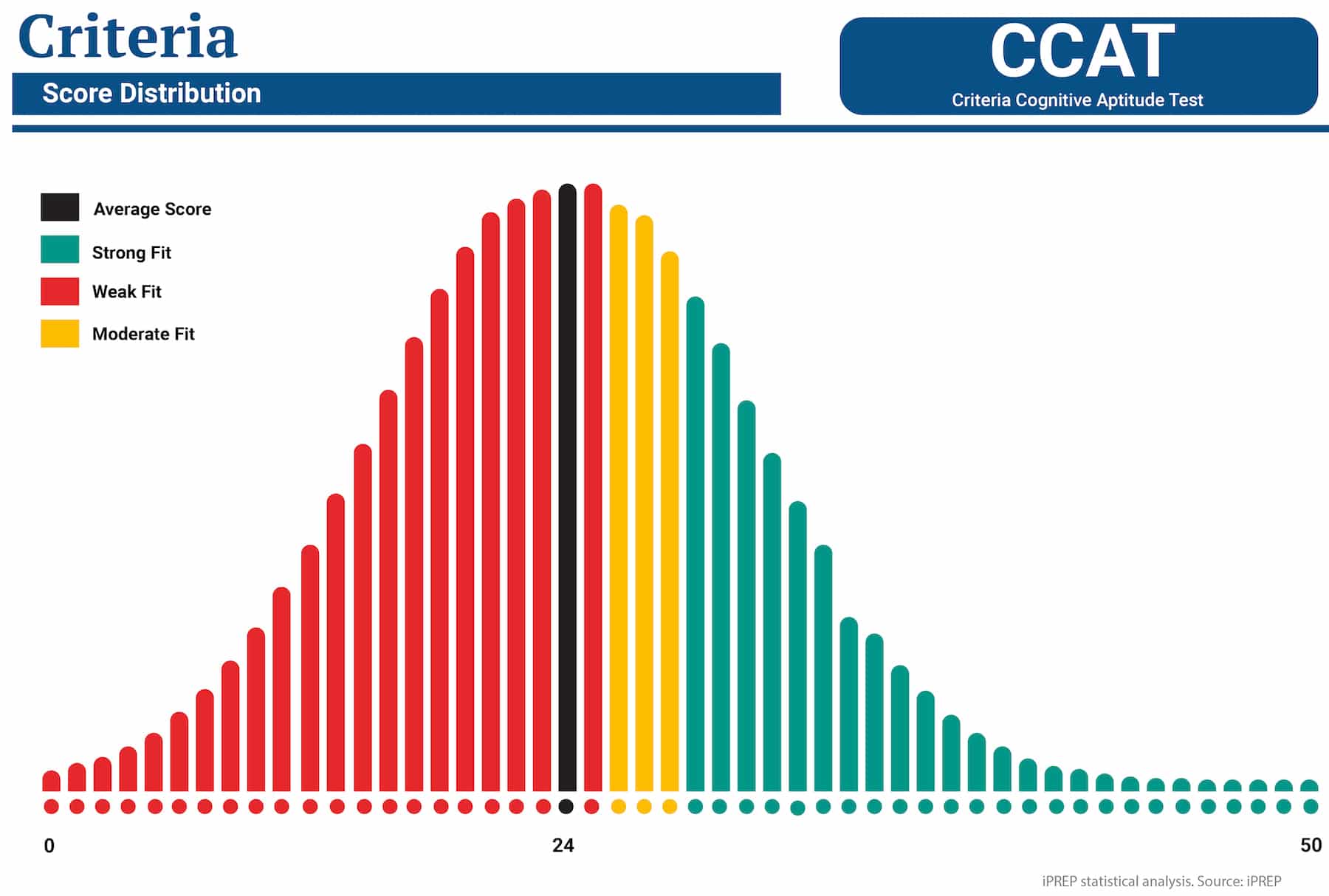
Well done!
You have completed the Sample Questions section.
The complete iPREP course includes full test simulations with detailed explanations and study guides.
‘…TESTS THAT ACTUALLY HELP’

In the first 30 minutes of use I have learned so much more than skipping along the internet looking for free content. Don’t waste you time, pay and get tests that actually help.
Richard Rodgers
January 28, 2020 at 7:49 PM
About the course
Welcome to iPrep’s Criteria Cognitive Aptitude Test (CCAT) Course. This course will help you boost your skills and with it your confidence towards your upcoming CCAT test. The course will provide you with the following tools and benefits:
- You will become familiar with the test’s various types of questions.
- You will be given 6 full-length CCAT-style simulation tests. These simulations include similar questions to those you will encounter in the real test with the same level of difficulty. They also have the same time limit as the real test. Experiencing the test’s time pressure will ensure it will not come as a surprise on test day.
- You will be provided with a great variety of helpful tips for the different types of questions. Some of the tips are in the introductory sections while most are in the detailed explanations that follow each question.
5.5
Learning hours
9
Practice tests
360
Questions
360
Videos
By the end of this course, you will be more knowledgeable and comfortable with the CCAT exam – Knowledge and familiarity with the test are the two most significant factors that can help you maximize your score and improve your chances of success.
The course is comprised of both practice and learning sessions. But first, you will go through an introductory sample test to get a feel for the challenge ahead. In it, you will solve questions with a time limit. Once done, you will have the option to review your answers and question explanations.
Following the introductory test experience, we will guide you through learning lessons with essential information about your upcoming CCAT test. These lessons will help you understand the underlying techniques that are essential for succeeding on the test.
The course is then concluded by its core component – simulating full-length tests that accurately follow the structure and concepts of the CCAT Test. Once done, you will be able to get full question explanations and even see how well you performed in comparison with other people who have taken the test.
Skills you will learn
Math-reasoning
Verbal-ability
Logical-reasoning
Non-verbal-reasoning
Curriculum
- Course Introduction
- Warming Up – Benchmark Simulation Test
- CCAT Question Types Introduction
- Time Management Tips
- Full-Length CCAT-Style Simulations
- Course Conclusion
About the author

M.A. Tamir Rubin
Psychology and Cognitive Sciences Expert
Tamir Rubin has been working in the field of Psychology and Cognitive Sciences for over ten years. His experience includes the development of tens of assessment test preparations in subjects such as Abstract Reasoning, Cognitive Ability, Critical Thinking, Deductive Reasoning, Inductive Reasoning, Numerical Reasoning, Verbal Reasoning, and more.
Rubin has been the Head Of Products for TestPrep, a global leader in assessment test preparation, and holds a Master’s degree from the Bar-Ilan University and a Bachelor’s degree from the Hebrew University.
Customer Testimonial

This was a very helpful course! When I started I got about average but with each test I got just about average. With each following test I have increased the my results by 6 points. Just did 2 real tests for 2 potential employers. Got 74% on first one and 78% for the second! Was the last I was notified that I was in the top 5% of applicants on this CCAT test. Hoping for the best ? Many thanks!!!
Eytan Strickland
July 23, 2019 at 2:31 PM
Reviews

Rebecca B***
June 20, 2025 at 6:29 PM
This prep course has boosted my skills as well as my confidence. I've taken many practice tests before but this one is through, polished, and the explanations are GOLD. Don't sleep on this for your preparations.

Keji A******
June 19, 2025 at 11:55 AM
Feel like I wasted my $30 and wish I could get it back. I was hoping to get consistent guidance throughout the program on how to answer the various types of questions that appear on the CCAT but this program didn't help there. The tutors providing explanations of how to work through problems (specifically math) had differing ways of solving problems that made it very confusing to follow a consistent structure of how to solve similiar problems. The guidance on the sentence completions and other english sections within the simulations seemed like a joke. Tips should be provided on how to figure out the meaning of the word if you don't know it (i.e. key root words, prefix etc to memorize). Simply telling me what the word means does absolutely nothing to help me learn, especially since the words are not recycled on the actual test.

iPrep
June 19, 2025 at 8:54 PM
Hi Keji. Thanks for your feedback. Cognitive aptitude tests can be tough, and we understand that different thinking styles call for different solving strategies—especially in math. That’s why our course includes a variety of solution methods across text and video explanations. If you find a method that works well for you, we encourage sticking with it consistently throughout. For verbal sections, your suggestion about root words and prefixes is a great one—we're working on making our tips even more actionable. We truly appreciate you sharing your experience.

Azadeh P**
May 31, 2025 at 8:12 PM
Found it very helpful for preparing for CCAT tests and understanding how to approach and answer the questions. The background on how to approach the personality tests were particularly helpful.

Cecilia O***********
April 25, 2025 at 5:19 PM
Same questions over and over again. I liked the explanation part, but the tests comprised the same questions. One of the mock tests had the same question back-to-back. I also had one test that would not refresh, so I couldn't repeat it to test my timing. The Benchmark test at the end should be different. So many of the same questions that your head starts to memorize the questions, so you are not learning and testing your ability to solve the questions in 15 minutes. Now I will try to find another mock test to practice, as I have already gone through everything here, and it is pointless to take the same test repeatedly. I'll give the group a 95% on the explanation part, but the tests themselves were not sufficient and too redundant.

iPrep
April 25, 2025 at 6:58 PM
Thanks for your feedback! Our CCAT course includes six different full-length practice tests. We checked your activity: you completed all six tests and retook three of them, which may have made some questions feel repetitive. We appreciate you sharing your experience and are always here if you need any further assistance!

Rafael B*********
April 4, 2025 at 11:21 AM
Great Course, video explanations and strategies helps a lot. Additionally real practice tests help sharpen math and spatial skills. It's a must have to do for a good pre-test warm-up.

Clint M****
March 18, 2025 at 7:25 PM
It really helped with my cognitve thinking and ability. I return and do practice on the quizes i have already taken to review and gain more knowledge of how to think.

Kristie M*****
March 3, 2025 at 4:10 AM
After reading such great reviews, I was expected a superior product. Unfortunately, that was not my experience. The questions in the first test were duplicates of questions in the pretest. That does not allow you to have accurate expectations. I'm working through the answers of the third test, and have discovered two examples where I selected the correct answer, but the key says I was wrong. This completely defeats the purpose and now I'm not quite sure what my score should be. I'm sure there are better products out there.

iPrep
March 3, 2025 at 6:50 AM
Hi Kristie. Thank you so much for the feedback. We carefully checked both issues and none is present on our tests. See below some details: Claim: Questions marked incorrectly despite selecting the correct answers. Check: Verified that no answers were actually selected by the user; the system accurately marked them as incorrect. Claim: Duplicate questions between pre-test and Test 1. Check: Carefully reviewed and confirmed all questions were unique, with no duplication.



















